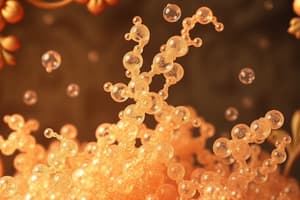Podcast
Questions and Answers
What is the defining characteristic of an aldose?
What is the defining characteristic of an aldose?
- Forms only hexoses
- Contains a ketone group
- Contains an aldehyde group (correct)
- Is abundant in cellulose
How is glucose prepared from sucrose?
How is glucose prepared from sucrose?
- By oxidation with nitric acid
- By reacting with hydroxylamine
- By converting starch to cellulose
- By boiling with dilute HCl or H2SO4 in alcoholic solution (correct)
What confirms the presence of a carbonyl group in glucose?
What confirms the presence of a carbonyl group in glucose?
- Formation of n-hexane on heating with HI
- Reaction with hydroxylamine to form an oxime (correct)
- Oxidation to form gluconic acid
- Addition of hydrogen cyanide to give cyanohydrin
Which reaction indicates the presence of an aldehydic group in glucose?
Which reaction indicates the presence of an aldehydic group in glucose?
What does acetylation of glucose with acetic anhydride confirm?
What does acetylation of glucose with acetic anhydride confirm?
Which statement is true about aldoses and ketoses?
Which statement is true about aldoses and ketoses?
Which group of carbohydrates yields two to ten monosaccharide units on hydrolysis?
Which group of carbohydrates yields two to ten monosaccharide units on hydrolysis?
What is the characteristic of polysaccharides that makes them not sweet in taste?
What is the characteristic of polysaccharides that makes them not sweet in taste?
How many monosaccharides are known to occur in nature?
How many monosaccharides are known to occur in nature?
Which carbohydrates are referred to as reducing sugars?
Which carbohydrates are referred to as reducing sugars?
Which type of carbohydrates cannot be hydrolysed further to give simpler units of polyhydroxy aldehyde or ketone?
Which type of carbohydrates cannot be hydrolysed further to give simpler units of polyhydroxy aldehyde or ketone?
What are carbohydrates classified as when they do not reduce Fehling’s solution and Tollens’ reagent?
What are carbohydrates classified as when they do not reduce Fehling’s solution and Tollens’ reagent?
Flashcards are hidden until you start studying
Study Notes
Classification of Carbohydrates
- Carbohydrates are classified based on their behavior on hydrolysis into three groups: monosaccharides, oligosaccharides, and polysaccharides.
Monosaccharides
- A monosaccharide is a carbohydrate that cannot be hydrolyzed further to give simpler units of polyhydroxy aldehyde or ketone.
- About 20 monosaccharides are known to occur in nature, with common examples including glucose, fructose, and ribose.
Oligosaccharides
- Oligosaccharides are carbohydrates that yield two to ten monosaccharide units on hydrolysis.
- They are further classified as disaccharides, trisaccharides, tetrasaccharides, etc., depending on the number of monosaccharides they provide on hydrolysis.
- Disaccharides are the most common oligosaccharides, and the two monosaccharide units obtained on hydrolysis may be the same or different.
Polysaccharides
- Polysaccharides are carbohydrates that yield a large number of monosaccharide units on hydrolysis.
- Examples include starch, cellulose, glycogen, and gums, which are not sweet in taste and are referred to as non-sugars.
Reducing and Non-Reducing Sugars
- Reducing sugars are carbohydrates that reduce Fehling's solution and Tollens' reagent.
- All monosaccharides, whether aldose or ketose, are reducing sugars.
Structure of Glucose
- Glucose is an aldohexose and is also known as dextrose.
- It is the monomer of many larger carbohydrates, including starch and cellulose.
- Glucose has the molecular formula C6H12O6 and its structure was determined based on several evidence:
- Prolonged heating with HI forms n-hexane, suggesting a straight chain of six carbon atoms.
- Glucose reacts with hydroxylamine to form an oxime and adds a molecule of hydrogen cyanide to give cyanohydrin, confirming the presence of a carbonyl group.
- Glucose gets oxidized to gluconic acid on reaction with a mild oxidizing agent like bromine water, indicating the presence of an aldehydic group.
- Acetylation of glucose with acetic anhydride gives glucose pentaacetate, confirming the presence of five –OH groups.
- On oxidation with nitric acid, glucose yields a dicarboxylic acid, saccharic acid, indicating the presence of a primary alcoholic (–OH) group.
Studying That Suits You
Use AI to generate personalized quizzes and flashcards to suit your learning preferences.




